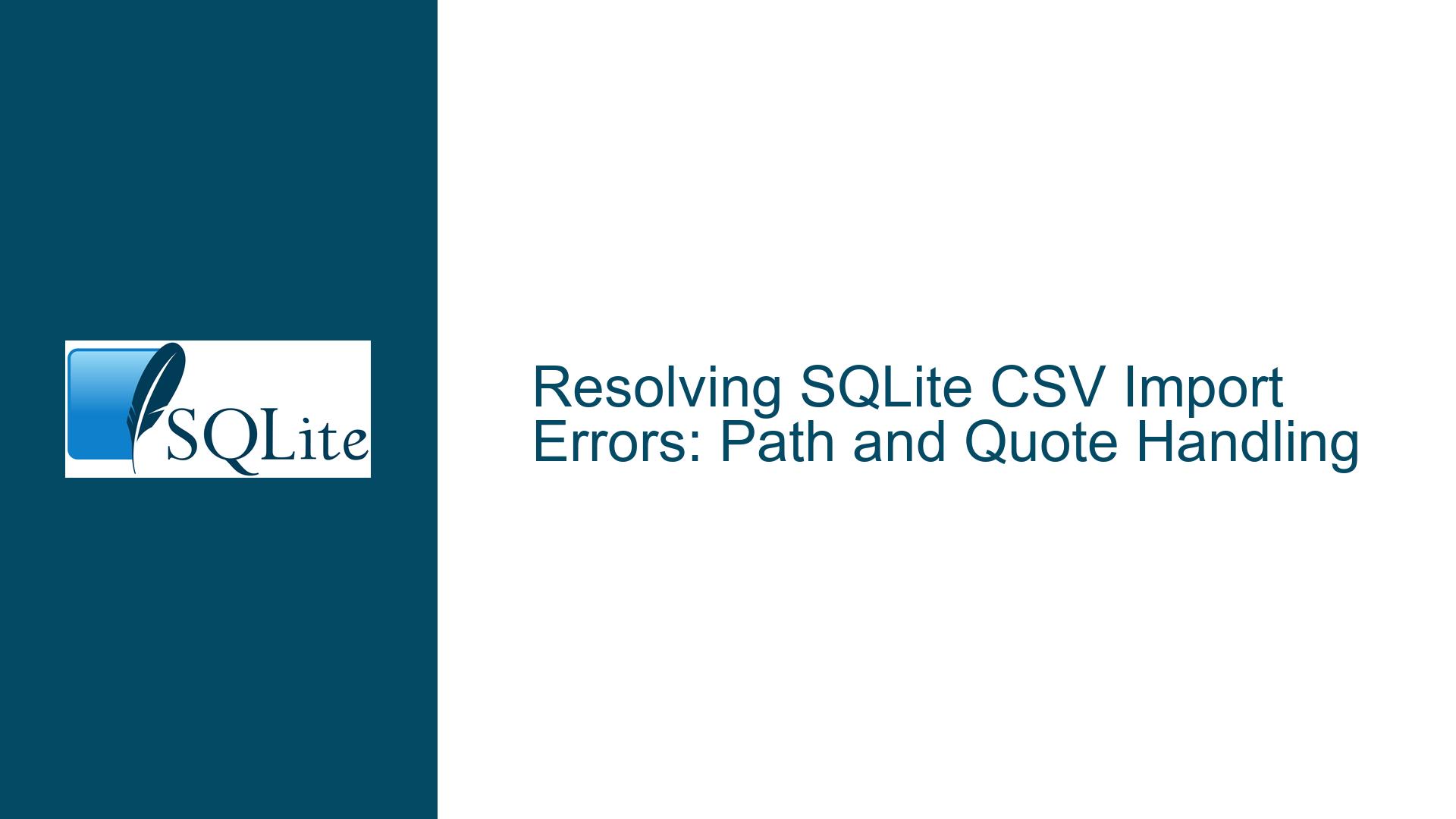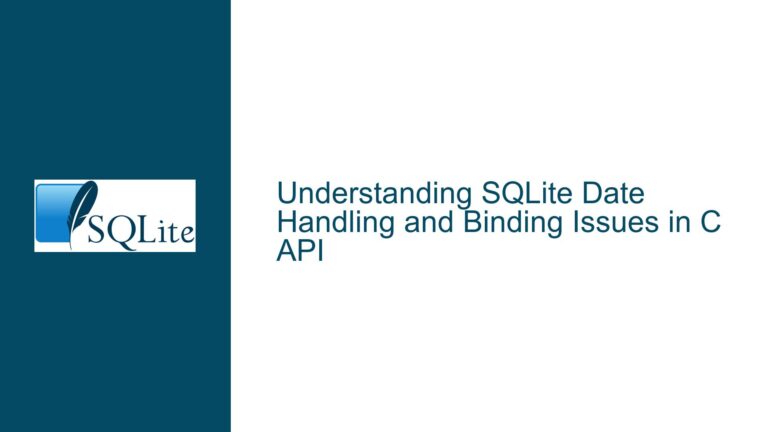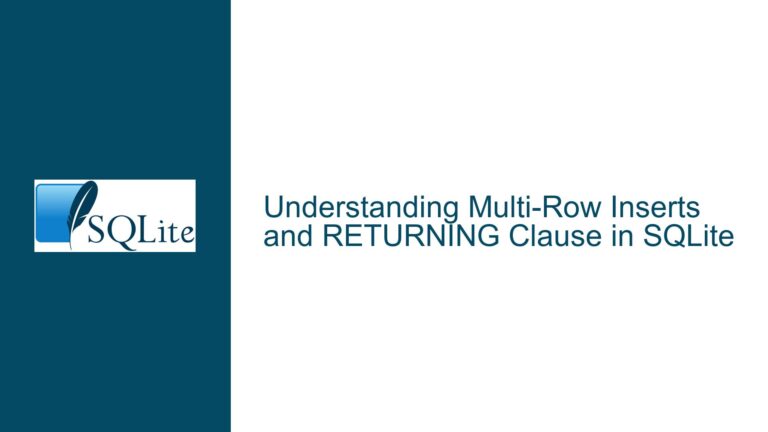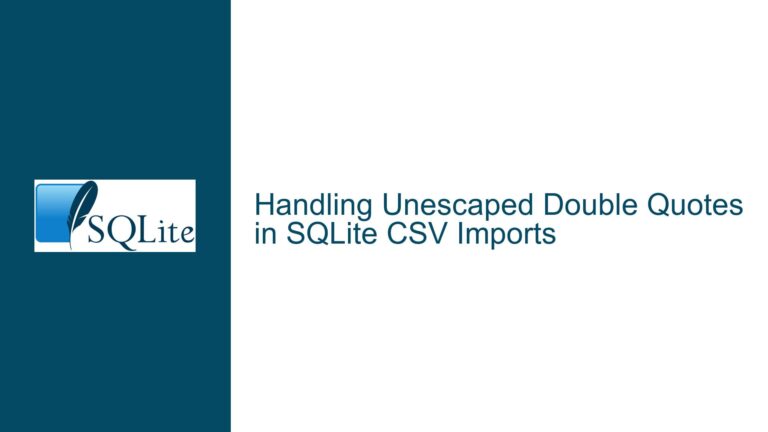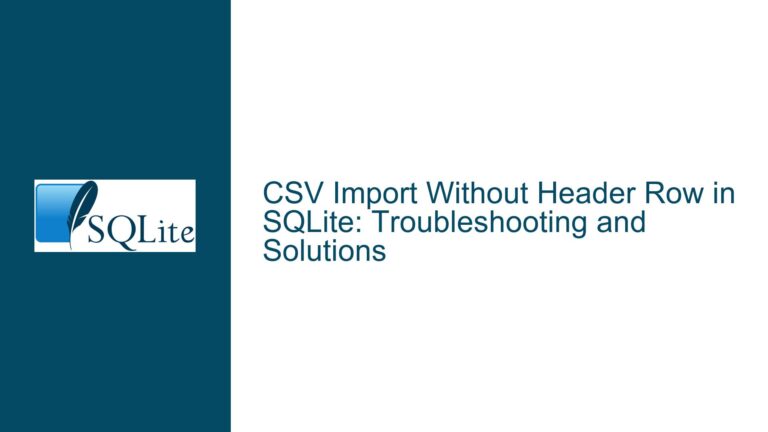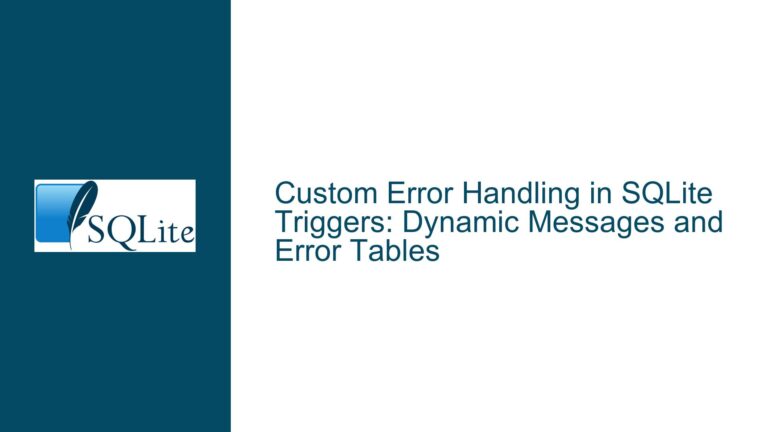Resolving SQLite CSV Import Errors: Path and Quote Handling
Issue Overview: CSV Import Failures Due to Path and Quote Misconfigurations
When attempting to import a CSV file into an SQLite database using the .import command, users often encounter errors related to file path formatting and quote usage. The primary symptoms include the inability to open the specified file, missing backslashes in the path, and errors related to unescaped quote characters within the CSV data. These issues are particularly prevalent when the file path contains spaces or special characters, or when the CSV data itself includes quotes that are not properly escaped.
The core of the problem lies in how SQLite’s command-line interface (CLI) interprets file paths and quotes. SQLite’s CLI is sensitive to the way paths are formatted, especially on Windows systems where backslashes are the default path separators. Additionally, the CLI has specific rules for handling quotes around file paths and within CSV data, which can lead to confusion and errors if not followed correctly.
Possible Causes: Path Formatting and Quote Misinterpretation
Backslash Handling in File Paths: On Windows, backslashes (
\) are used as path separators. However, in SQLite’s CLI, a single backslash is interpreted as an escape character. This means that when a file path likeC:\My Folder\Data.csvis provided, the CLI interprets\Mand\Das escape sequences rather than literal backslashes. This results in the path being misinterpreted, leading to the errorError: cannot open C:My FolderData.csv.Spaces in File Paths: File paths that contain spaces must be enclosed in quotes to be interpreted correctly by the CLI. Without quotes, the CLI treats each space-separated segment as a separate argument, causing the path to be split incorrectly. For example,
C:\My Folder\Data.csvwithout quotes is interpreted as two separate arguments:C:\MyandFolder\Data.csv.Unescaped Quotes in CSV Data: If the CSV file contains unescaped double quotes within its data, the
.importcommand may misinterpret these quotes as delimiters, leading to errors such asunescaped " character. This is particularly problematic when the CSV data includes text fields that contain quotes, as the CLI expects quotes to be properly escaped (usually by doubling them, e.g.,"").Forward Slashes vs. Backslashes: While Windows traditionally uses backslashes as path separators, modern operating systems, including Windows, also accept forward slashes (
/). However, the behavior of the CLI may vary depending on the operating system and the specific version of SQLite being used. In some cases, using forward slashes can simplify path handling, but this is not always consistent.Table Structure Mismatch: Another potential cause of import errors is a mismatch between the structure of the CSV file and the target table. If the table columns do not match the CSV data in terms of number, order, or data types, the import process may fail. This can result in errors such as
record number: unescaped " characterorError: Cannot open file.
Troubleshooting Steps, Solutions & Fixes: Ensuring Successful CSV Imports
Correctly Formatting File Paths:
- Double Backslashes: To ensure that backslashes are interpreted correctly, use double backslashes (
\\) in the file path. For example, instead ofC:\My Folder\Data.csv, useC:\\My Folder\\Data.csv. This ensures that each backslash is treated as a literal character rather than an escape sequence. - Quoting Paths with Spaces: Always enclose file paths that contain spaces in double quotes. For example, use
"C:\\My Folder\\Data.csv"instead ofC:\My Folder\Data.csv. This prevents the CLI from splitting the path into multiple arguments. - Using Forward Slashes: As an alternative to backslashes, consider using forward slashes (
/) in the file path. For example,C:/My Folder/Data.csv. This approach is often more consistent across different operating systems and can simplify path handling.
- Double Backslashes: To ensure that backslashes are interpreted correctly, use double backslashes (
Handling Quotes in CSV Data:
- Escaping Quotes: Ensure that any quotes within the CSV data are properly escaped. In most cases, this involves doubling the quotes. For example, if a text field contains the value
"Hello, World!", it should be written as""Hello, World!""in the CSV file. - Using the
--csvFlag: When importing CSV files, use the--csvflag with the.importcommand to explicitly specify that the file is in CSV format. This ensures that the CLI handles quotes and delimiters correctly. For example,.import --csv "C:\\My Folder\\Data.csv" MyTable.
- Escaping Quotes: Ensure that any quotes within the CSV data are properly escaped. In most cases, this involves doubling the quotes. For example, if a text field contains the value
Verifying Table Structure:
- Matching Columns: Before importing, ensure that the target table’s structure matches the CSV file’s data. This includes verifying the number of columns, their order, and their data types. If necessary, recreate the table with the correct structure before attempting the import.
- Using
.schemaCommand: Use the.schemacommand to inspect the structure of the target table. This can help identify any discrepancies between the table and the CSV file.
Testing with a Simplified Path:
- Local File Import: As a troubleshooting step, try importing the CSV file from the same directory where the SQLite executable is located. This eliminates potential issues related to path formatting. For example, if the file is named
Data.csvand is in the same directory assqlite3.exe, use the command.import Data.csv MyTable. - Gradual Path Complexity: If the import works with a local file, gradually increase the complexity of the path (e.g., adding subdirectories) to identify where the issue arises. This can help pinpoint whether the problem is related to path length, special characters, or other factors.
- Local File Import: As a troubleshooting step, try importing the CSV file from the same directory where the SQLite executable is located. This eliminates potential issues related to path formatting. For example, if the file is named
Reviewing CLI Documentation:
- CLI Path Handling: Refer to the SQLite CLI documentation, particularly section 4.2, which covers path handling and the use of quotes. This section provides detailed information on how the CLI interprets file paths and quotes, which can help avoid common pitfalls.
- Markdown Rules: Be aware of how Markdown formatting affects the display of backslashes in forum posts. This can sometimes obscure the actual command being used, leading to confusion.
Using Transcripts for Debugging:
- Providing Exact Commands: When seeking help, provide a transcript of the SQLite session that includes the exact commands used and the resulting errors. This helps others replicate the issue and provide accurate solutions. Use triple backticks to format the transcript for clarity.
- Example Transcript:
sqlite> .import --csv "C:\\My Folder\\Data.csv" MyTable Error: cannot open "C:My FolderData.csv"
Recreating the Table:
- Resolving Structural Issues: If the import fails due to table structure issues, recreate the table with the correct structure. This can resolve errors related to mismatched columns or data types. For example:
sqlite> DROP TABLE MyTable; sqlite> CREATE TABLE MyTable (Column1 TEXT, Column2 INTEGER, ...); sqlite> .import --csv "C:\\My Folder\\Data.csv" MyTable
- Resolving Structural Issues: If the import fails due to table structure issues, recreate the table with the correct structure. This can resolve errors related to mismatched columns or data types. For example:
By following these troubleshooting steps and solutions, users can effectively resolve common issues related to CSV imports in SQLite. Properly formatting file paths, handling quotes in CSV data, and ensuring table structure compatibility are key to successful imports. Additionally, understanding how the SQLite CLI interprets paths and quotes can prevent many of the errors encountered during the import process.
